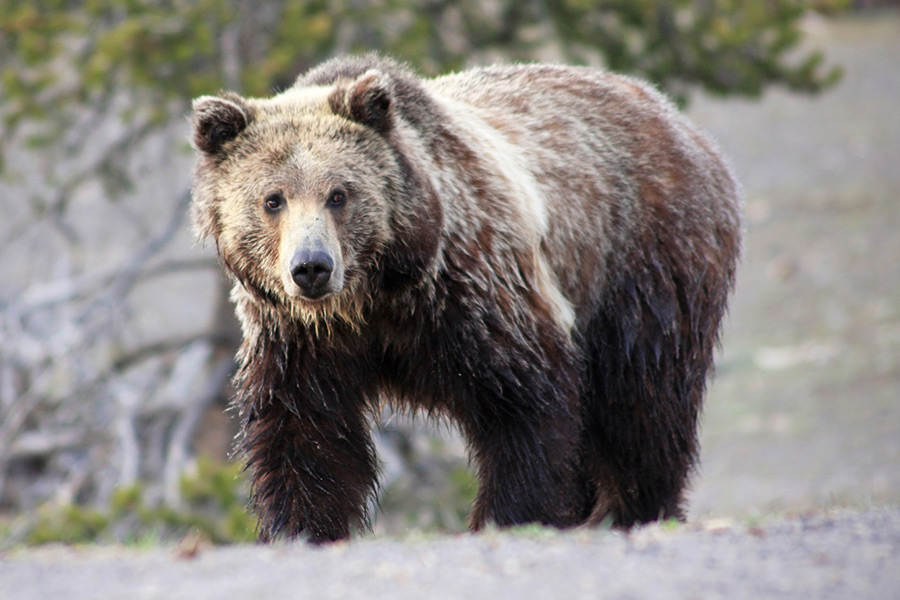BILLINGS – Wildlife officials have divvied up how many grizzly bears can be killed by hunters in the Yellowstone region of Wyoming, Montana and Idaho as the states seek control of a species shielded from hunting for the past 40 years, according to documents obtained by The Associated Press.
The region’s grizzlies have federal protections, but that could change in coming months, turning control over to the states. The AP obtained a draft agreement detailing the states’ plans for the animals.
The deal puts no limits on grizzly bear hunting outside a 19,300-square-mile management zone centered on Yellowstone National Park. Inside the zone, which includes wilderness and forest lands near the park, hunters in Wyoming would get a 58 percent share of the harvest, a reflection that it’s home to the bulk of the region’s bears. Montana would get 34 percent, and Idaho, 8 percent.
The management zone has an estimated minimum 717 grizzly bears. There is no estimate of how many live outside the area, although the number is increasing as they expand into new habitat, biologists say.
Wildlife advocates say the bear population remains too small to withstand much hunting. That’s a particular concern given the large numbers of bears already dying, including during surprise run-ins with hunters and after livestock attacks that prompt officials to trap and kill problem bears.
In 2015, at least 59 Yellowstone-area grizzlies were believed to have been killed or trapped and removed by government agencies. That’s the most since the animal received protection under the Endangered Species Act in 1975.
Despite the deaths, state officials say the grizzly population has recovered from excessive hunting and trapping that exterminated grizzlies across most of the U.S. in the early 1900s. The officials have increased pressure on U.S. Fish and Wildlife Director Dan Ashe in recent months to revoke the animal’s threatened status.
Directors of the three states’ wildlife agencies told Ashe in a Dec. 4 letter that such a step was long overdue.
“It is critically important that we capitalize on our tremendous progress and momentum … by proceeding with a long overdue delisting” of bears from the threatened species list, the directors wrote. It was signed by Idaho Fish and Game Director Virgil Moore; Montana Fish, Wildlife and Parks Director Jeff Hagener; and Wyoming Game and Fish Director Scott Talbott.
Wildlife advocates and some bear researchers dispute government claims that the Yellowstone bear population is stable or increasing. A closer look at the trends suggests it’s actually in decline, said David Mattson, a former grizzly researcher with the U.S. Geological Survey.
“All indicators are we have a population that’s in trouble,” Mattson said Monday. “It boggles my mind that people would consider going down this path that could consist of implementing a sport hunt.”
Mattson said he retired in 2013 in part so he could be more vocal on the issue of protecting bears. He helps run a blog called Grizzly Times, which he co-founded with his wife, Montana wildlife activist Louisa Wilcox.
Legal hunting of Yellowstone-area grizzlies last occurred in the 1970s.
At least 58 bears were killed in Montana and Idaho in the five years leading up to a prohibition on hunting in 1975. Historical harvest figures for Idaho were not available.
Any future hunts would be conservative and need approval from wildlife commissioners following a public comment period, said Quentin Kujala, chief of wildlife management for Montana Fish Wildlife and Parks.
The size of each harvest would be on a sliding scale, with the intention of keeping the bear population viable and avoiding the need to reinstate federal protections, Kujala said. More hunting would be possible when the population tops 675 bears, and hunting would be largely barred if the number falls below 600.
“We’re definitely not talking about a large number. We’re not talking hundreds or anywhere near that,” Wyoming Game and Fish spokesman Renny MacKay said.
A decision on whether protections should be lifted is due early this year, according to the U.S. Fish and Wildlife Service. Barring a successful court challenge, it would take approximately a year for such a rule to go into effect.
The pending agreement between the states is not required for federal protections to be lifted, state officials said.
